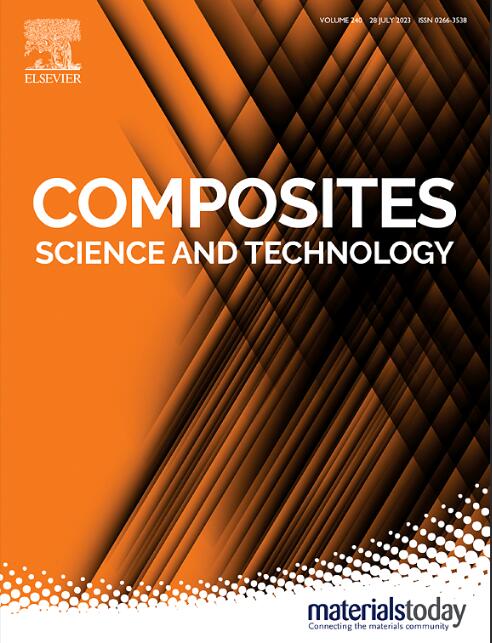On the development of mode II interlaminar damage-tolerant additive manufactured continuous fiber-reinforced polymers: An interlaminar hybridization strategy
IF 8.3
1区 材料科学
Q1 MATERIALS SCIENCE, COMPOSITES
引用次数: 0
Abstract
Weak interlaminar bonding in 3D-printed continuous fiber-reinforced polymers (CFRP) results from inadequate interdiffusion during fabrication, leading to delamination, which is the most catastrophic failure mode. This poses a significant limitation in the application of 3D-printed CFRP. While recent studies have focused primarily on characterizing fracture toughness, a substantial gap remains in developing innovative interlaminar damage-tolerant designs. The main contribution of this study is to implement an interlaminar hybridization strategy using a co-extrusion process that integrates carbon fibers, known for their low toughness, with Kevlar, which offers superior fracture toughness, to improve resistance to mode II delamination propagation. End-notched flexure (ENF) tests are conducted to characterize the initiation and propagation fracture toughness at pure carbon (C//C), pure Kevlar (K//K), and hybrid (C//K) interfaces using the compliance calibration method (CCM), direct beam theory (DBT), and compliance-based beam theory (CBBM). The most significant finding is that hybridization results in a remarkable difference of 709% in propagation toughness at the C//K interface, demonstrating a rising R-curve compared to the unstable delamination growth observed at the C//C interface.Fractographic analysis indicates that extensive Kevlar bridging behind the crack tip is the primary toughening mechanism. Furthermore, hybridization creates an intrinsic fracture process zone ahead of the crack, significantly enhancing energy absorption. The interaction between carbon and Kevlar, which leads to carbon pull-out, is identified as a positive side effect of hybridization. These findings provide critical insights into interlaminar bonding mechanisms influenced by hybridization, highlighting the potential for next-generation 3D-printed composites in real applications employing a damage-tolerant design philosophy.

论II型层间耐损伤添加剂制造连续纤维增强聚合物的发展:层间杂交策略
在3d打印连续纤维增强聚合物(CFRP)中,由于制造过程中相互扩散不充分,导致层间结合弱,导致分层,这是最严重的破坏模式。这对3d打印CFRP的应用造成了很大的限制。虽然最近的研究主要集中在表征断裂韧性,但在开发创新的层间损伤容限设计方面仍然存在很大差距。本研究的主要贡献是采用共挤压工艺实现层间杂交策略,该工艺将以低韧性著称的碳纤维与具有优异断裂韧性的凯夫拉纤维结合在一起,以提高对II型分层扩展的抵抗力。采用柔度校准方法(CCM)、直接梁理论(DBT)和基于柔度的梁理论(CBBM),对纯碳(C//C)、纯凯夫拉(K//K)和混合(C//K)界面进行了端缺口弯曲(ENF)试验,以表征起裂韧性和扩展断裂韧性。最显著的发现是,杂化导致C//K界面的扩展韧性差异达709%,与C//C界面的不稳定分层生长相比,r曲线呈上升趋势。断口分析表明,裂纹尖端后广泛的凯夫拉纤维桥接是主要的增韧机制。此外,杂化在裂纹前方形成了一个本征断裂过程区,显著提高了能量吸收。碳和凯夫拉尔之间的相互作用,导致碳拉出,被认为是杂化的一个积极的副作用。这些发现为研究受杂化影响的层间键合机制提供了重要见解,突出了采用损伤容忍设计理念的下一代3d打印复合材料在实际应用中的潜力。
本文章由计算机程序翻译,如有差异,请以英文原文为准。
求助全文
约1分钟内获得全文
求助全文
来源期刊

Composites Science and Technology
工程技术-材料科学:复合
CiteScore
16.20
自引率
9.90%
发文量
611
审稿时长
33 days
期刊介绍:
Composites Science and Technology publishes refereed original articles on the fundamental and applied science of engineering composites. The focus of this journal is on polymeric matrix composites with reinforcements/fillers ranging from nano- to macro-scale. CSTE encourages manuscripts reporting unique, innovative contributions to the physics, chemistry, materials science and applied mechanics aspects of advanced composites.
Besides traditional fiber reinforced composites, novel composites with significant potential for engineering applications are encouraged.
 求助内容:
求助内容: 应助结果提醒方式:
应助结果提醒方式:


